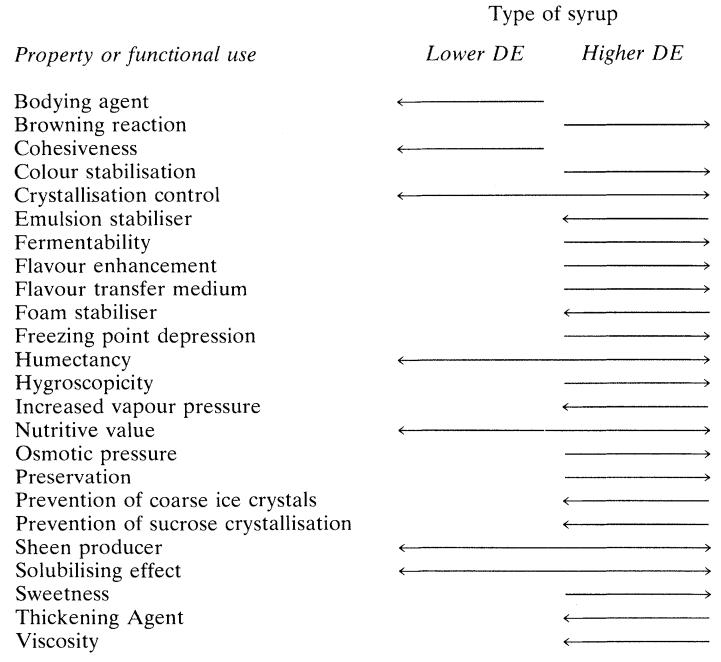The figure below gives a comprehensive list of the properties of glucose syrup as a function of the DE. Five of the more important points are discussed here.

Browning reaction
This is basically a condensation reaction between amino acids and reducing sugars, generally called non-enzymic browning or Maillard reaction. The reaction is enhanced by glucose syrups containing high levels of dextrose.
Crystallization control
Crystallization control of sucrose and other sugars such as lactose can be affected by means of glucose syrup. Low DE glucose syrups, because of their increased viscosity, have the greatest effect in slowing down the rate of crystallization.
Humectancy
Humectancy is the ability to resist changes in moisture content, either by drying out or by picking up water. Compared to sucrose, glucose syrups are composed mainly of high molecular weight carbohydrates and at a given weight contribute fewer molecules. The equilibrium relative humidity (ERH) is therefore increased in food products where glucose syrup is employed. It, therefore, follows that high DE glucose syrups with a lower average molecular weight are more hygroscopic than low DE glucose syrups.
Sweetness
The sweetness of glucose syrup is generally expressed as relative sweetness, that is, as compared to sucrose, which is arbitrarily taken as 100. Many studies on the relative sweetness of glucose syrup have been conducted. The main conclusion emerging from these studies is that the relative sweetness of glucose syrup, like that of other natural sugars, is not a constant value but increases with increasing concentration. When a glucose syrup is mixed with sucrose, there is a synergistic sweetening effect, that is, their combined sweetness is greater than would be the case if they were used individually.
Viscosity
The viscosity of glucose syrup in relation to its solids content and temperature is an important factor when the product has to be pumped and stored, as heating may need to be provided for storage tanks and heavy duty pumps required to transfer the material. The viscosity of a glucose syrup is directly related to its moisture content and its molecular weight (and thus inversely related to DE). It is also related to the carbohydrate composition of the syrup and this effect is particularly significant when selecting a glucose syrup for confectionery manufacture. A 42 DE high maltose syrup for example has a lower viscosity than a 42 DE acid-converted syrup at the same solids content. Temperature is very important in relation to viscosity and viscosity decreases as temperature increases. Hydrogenation, predictably, has no apparent effect on the viscosity of glucose syrup.
